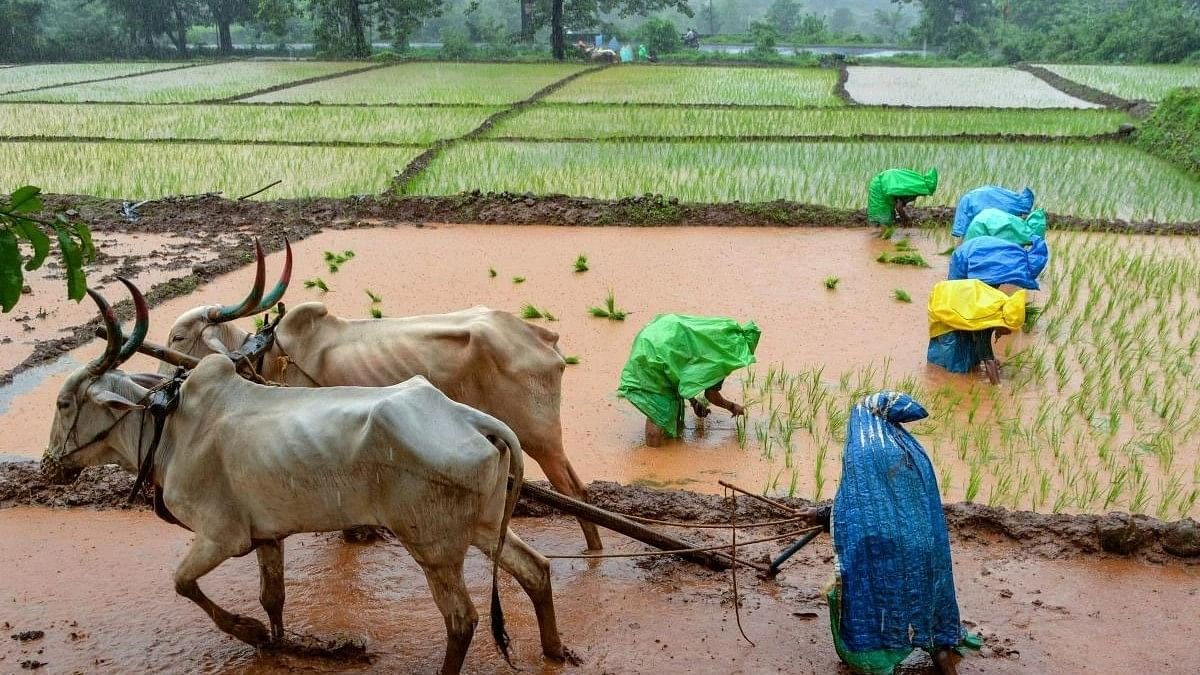
Representative image.
Credit: PTI File Photo
Union Finance Minister Nirmala Sitharaman unveiled the interim budget for 2024-25, setting forth a vision for India to evolve into a ‘Viksit Bharat’ (developed India) by 2047. With 45.8% of the workforce engaged in the agriculture sector, feeding a vast and expanding population, its intimate connection with poverty is undeniable.
Consequently, considerable anticipation surrounded the budget, as significant expectations were pinned on its provisions. However, the budgetary allocation for the Department of Agriculture and Farmers Welfare has experienced only a slight increase from the previous year, rising by a mere 0.63% in nominal terms.
The budget unveiled a moderate increase in allocations for key initiatives such as the Modified Interest Subvention Scheme (MISS), Formation and Promotion of 10,000 Farmer Producer Organisations (FPOs), the Rashtriya Krishi Vikas Yojana and so on.
However, the budget also witnessed a reduction in expenditures, particularly notable in the realm of subsidies that are crucial for farmers’ sustenance. The allocation for food subsidy, for instance, saw a decrease, from Rs 2.12 trillion in the revised estimates of 2023-24 to Rs 2.05 trillion in the budget estimates for 2024-25.
Similarly, the allocation for fertiliser subsidies, which serve as a significant support mechanism for farmers, experienced a notable decline from the revised estimate of Rs 1.89 trillion in 2023-24 to the budget estimate of Rs 1.64 trillion in 2024-25.
The allocation for the Pradhan Mantri Kisan Samman Nidhi (PM-Kisan) programme remained stagnant at Rs 60,000 crore in the budgeted estimate for 2024-25, potentially falling short of farmers’ expectations for an increase in support.
During the Modi administration’s decade-long tenure from 2014-15 to 2023-24, the agriculture sector witnessed an average growth rate of 3.55%, reflecting a moderate performance. However, the preceding year marked a tumultuous period for the sector, experiencing a significant downturn
with an average growth rate plummeting to a mere 1.8%.
Moreover, the PM’s vision of doubling farmers’ income remained unrealised over the past two decades, with only marginal increases observed in farmers’ real income during this period. To achieve the ambitious goal of doubling farmers’ income from the 2015-16 level, an annual growth rate of 10.4% was required from 2015-16 to 2022-23.
However, contrary to this target, farmers’ income experienced a sluggish growth, averaging at a mere 3% per annum between 2012-13 and 2018-19, according to the latest MoSPI data (Situation Assessment Survey, 2018-19).
Given the emphasis placed on the welfare and aspirations of ‘annadata’ (farmers) in the budget speech, there was an anticipation for the government to roll out a series of substantial policies, particularly with the General Election looming.
Nonetheless, the agricultural budget appears subdued. It is imperative to provide timely encouragement and secure stable income for farmers to address their needs effectively. Anticipation now turns toward the post-election July budget for significant policy-level announcements.
So, what policy insights can propel the agriculture sector towards substantial income augmentation for farmers while fostering sustainability?
1) According to the SAS data for 2018-19, states with robust procurement policies demonstrate higher agricultural income. On average, farmers with access to procurement agencies were estimated to earn a monthly income from crop cultivation of Rs 8,769, whereas those without such access had an estimated monthly income of only Rs 3,303. However, the challenge with the procurement policy is that implementation remains concentrated in a few states. Due to extensive procurement as a percentage of state production, paddy’s wholesale price surged to Rs 2,634/quintal and Rs 2,239/quintal in Punjab and Haryana, respectively, during the harvest months in 2023.
Conversely, in West Bengal, where government procurement is minimal, the wholesale price of paddy at Rs 2,126 per quintal remained below the Minimum Support Price (MSP) in 2023. In the budget, it was emphasised that the government would prioritise efforts to transform the eastern region and its populace into a significant catalyst for India’s overall economic growth. Therefore, it is imperative to focus on securing improved returns for farmers in the eastern states, where their incomes are among the lowest.
2) The existing MSP policy heavily favours wheat and rice production, creating a lopsided incentive structure. In contrast, despite shortages, pulses and oilseeds often suffer from prices below the MSP, lacking effective price support mechanisms. To alleviate farmers’ reliance on monocropping of paddy and wheat and facilitate diversification towards other grains and oilseeds, the government must foster a supportive environment. This necessitates the initiation of a dedicated crop diversification policy wherein farmers receive assistance for procuring essential inputs and are assured a market for their produce.
3) Over the period from 2002-03 to 2018-19, there has been a significant shift in the income distribution within the agricultural sector, with the share of income derived from the livestock sector experiencing a remarkable increase from 4.3% to 15.7%.
Conversely, the contribution from crop cultivation witnessed a decline from 45.8% to 37.7% during the same time period (SAS, 2018-19). These trends suggest that there is greater potential for increasing farmers’ incomes through the farming of animals, including pisciculture, rather than solely relying on crop cultivation.
The prudent approach entails prioritising investments in animal husbandry, including fisheries. Despite a significant increase in budgetary support for the ministries of animal husbandry and fisheries compared to previous year’s allocations, the total allocation for centrally sponsored schemes under the Department of Animal Husbandry and Dairying remains modest at Rs 3,906 crore. Similarly, funding for schemes associated with the blue revolution amounts to just Rs 2,352 crore.
Investing significantly to develop efficient value chains based on a cluster
approach emerges as the most favourable strategy.
(The writer is a research fellow with ICRIER)